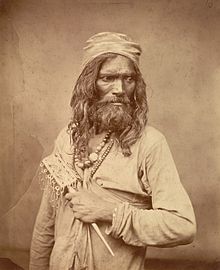Madariyya
This article needs additional citations for verification. (August 2009) |
| Part of a series on |
| Islam |
|---|
 |
|
| Part of a series on Islam Sufism |
|---|
 |
|
|

The Madariyya are members of a Sufi order (tariqa) popular in North India, especially in Uttar Pradesh, the Mewat region, Bihar, Gujarat and West Bengal, as well as in Nepal and Bangladesh. Known for its syncretic aspects and focus on internal dhikr, it was initiated by the Sufi saint Badi al-Din ("Shah Madar"; d. 1434 CE), and is centered on his shrine (dargah) at Makanpur, Kanpur district, Uttar Pradesh. He came to India in the eight century A.D.in Gujrat at first time and he came to India last time in the thirteenth century along with the saint Ashraf Jahangir Semnani.[1]
Originating from the Tayfuriya order, as his Pir, spiritual teacher was Bayazid Tayfur al-Bistami, Madariya reached its zenith in the late Mughal period between 15th to 17th century, and gave rise to new orders as Madar's disciples spread through the northern plains of India, into Bengal. As with most Sufi orders, its name Madariya has been created by adding a Nisba to the name of its founder Madar, leading to Madariya, sometimes spelled as Madariyya, though it is also referred as Tabaqatiya.[2][3][4][5][6]
Dargah[]
The Dargah, or the tomb of Badi al-Din Shah Madar, is located at Makanpur, near Kanpur city, in Uttar Pradesh state, India. It is visited by thousands of visitors every month and especially during the annual Urs celebrations.[7]
Prominent Saints of Madariyya Order[]
- Sadan Shah Sarmast disciple of Zinda Shah Madar, Tomb in Gujarat
- Syed Akmal Husain Urf Babamaan disciple of Sadan Shah Sarmast, Tomb in Vadodara, Gujarat
- Chote Mast Dada disciple of Sadan Shah Sarmast, Tomb in Vadodara, Gujarat
- Syed Jamaluddin Janeman Jannati Madari R. A, Hilsa(jattipur), Bihar.
See also[]
- Jogi
- Moinuddin Chishti
- Ashraf Jahangir Semnani
Hazrath Syed ghoda madarsha Wali
References[]
- ^ 'Hayate Makhdoom Syed Ashraf Jahangir Semnani(1975), Second Edition(2017) ISBN 978-93-85295-54-6, Maktaba Jamia Ltd, Shamshad Market, Aligarh 202002, India
- ^ Masud, Muhammad Khalid (2000). Travellers in faith: studies of the Tablīghī Jamāʻat as a transnational Islamic movement for faith renewal- Volume 69. BRILL. p. xxxii. ISBN 90-04-11622-2.
- ^ Liebeskind, Claudia (1998). Piety on its knees: three Sufi traditions in South Asia in modern times. Oxford University Press. p. 49. ISBN 0-19-564309-7.
- ^ Ghazzālī; George F. McLean (2001). Deliverance from error and mystical union with the Almighty- Volume 2 of Cultural heritage and contemporary change. CRVP. p. 60. ISBN 1-56518-081-X.
- ^ Bakshi, S.R. (2003). Advanced history of medieval India. Anmol Publications PVT. LTD. p. 348. ISBN 81-7488-028-3.
- ^ Harris, Ian (1992). Contemporary religions: a world guide- Longman current affairs. Longman. p. 216. ISBN 0-582-08695-7.
- ^ Kanpur Dargahs in India.
External links[]
- Sufism in Pakistan
- Sufism in India
- Sufism in Bangladesh
- Sufi orders